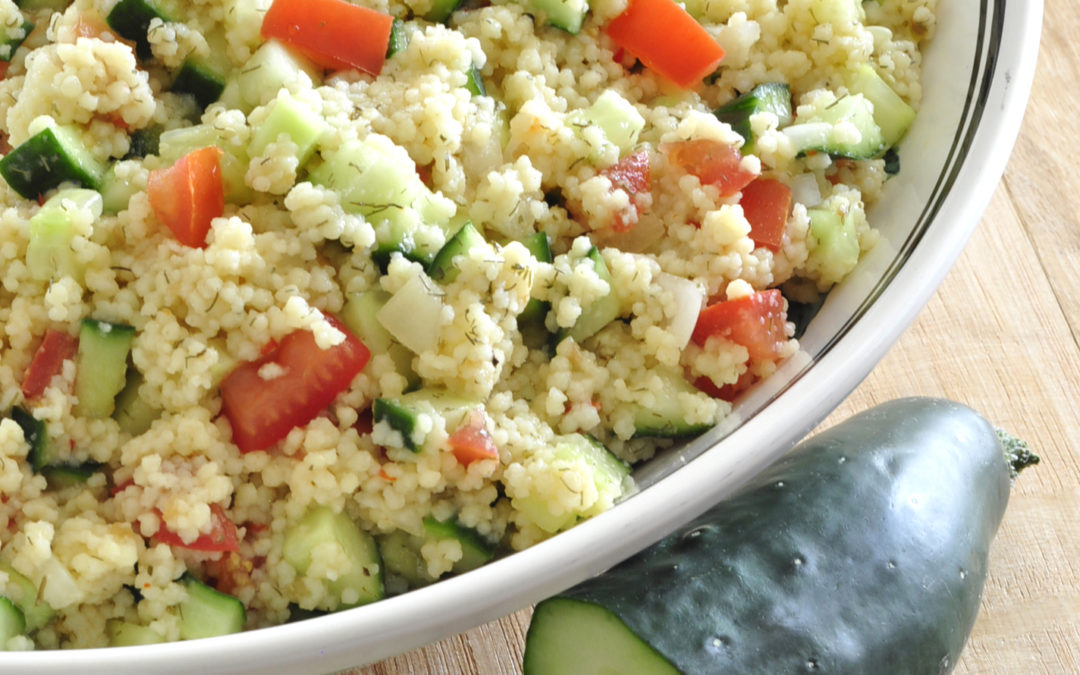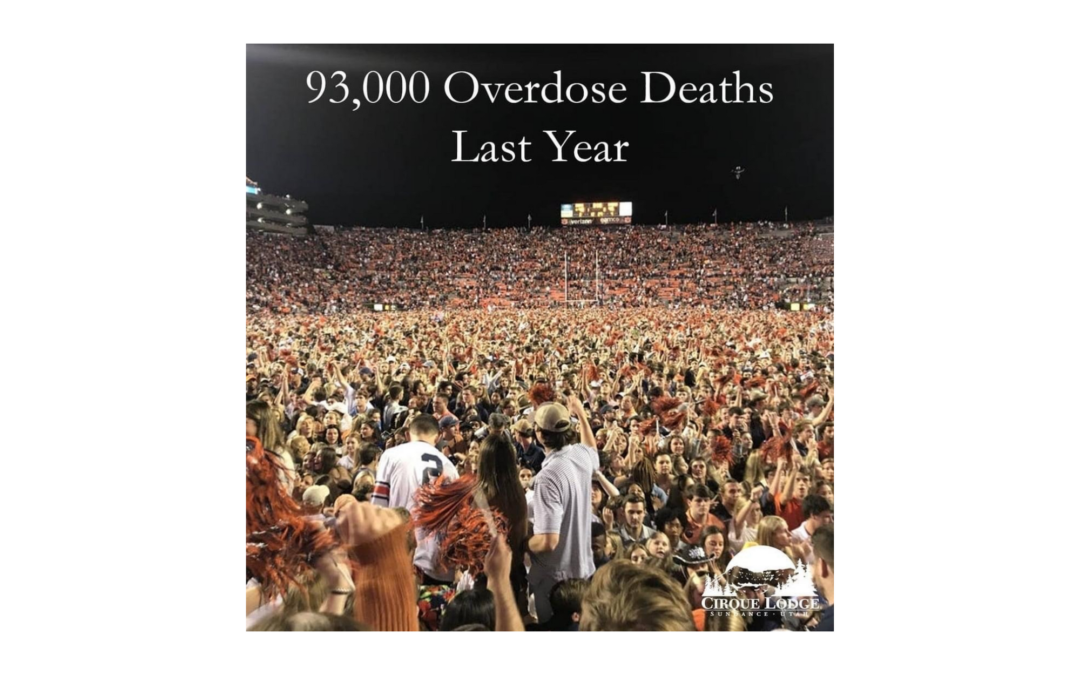
by Guest | Oct 6, 2021 | Lunch & Snack Recipes, Recipes
Prep Time: 15 minutes
Makes: 5 cups
Ingredients
- 2 cups diced cucumbers
- 1 cup seeded and diced tomato
- ¼ cup chopped sweet onion
- 2 cups cooked couscous or rice
- 2 teaspoons dill weed
- ½ cup low-fat italian salad dressing
Directions
- Toss together the cucumber, tomatoes, onions, couscous or rice, dill weed and salad dressing.
- For best flavor, chill for 1 hour before serving.
- Refrigerate leftovers within 2 hours.
Notes
- Use brown rice to include whole grains
Recipe & Photo Source: https://www.foodhero.org/recipes/cucumber-salad-tomatoes

by Guest | Oct 6, 2021 | Being Well
Families, teachers, friends, and neighbors all contribute and reinforce positive traits in young people in our community. Here are some handy tips to consider when supporting young people during any difficult or stressful period of their lives.
Key Concepts:
Grit is the sustained drive that maintains commitment despite obstacles and time. Think about determination, perseverance, and believing in oneself. Good character references include Moana, Frodo, and any movie starring Clint Eastwood.
Resilience is the ability and gumption to recover from difficult set-backs. Think bouncing back, getting back on a horse, and pulling up your bootstraps. Good character references include Justin Beiber, Venus and Serena Williams, and Forrest Gump.
The following are a few ideas on how to cultivate these traits in young people; especially during large transitions and stressful situations.
Harvest a growth mindset
How we speak about our goals, failures, and victories not only shapes our reality, it lays foundations for them too. Steering these conversations can be difficult but these tips can help you prepare to plant seeds of resilience.
- Normalize failure. It is a valuable part of the process and makes room for reality and humility. It can be helpful to throw in stories of your own experience with obstacles and how you recovered.
- Value progress over product. Perfectionism in a final result can overlook the importance of experiential learning. This process is where children learn essential skills like creation, communication, and resource utilization.
- Focus on language. Try to avoid blame, shame, and indifference with your children’s setbacks. Approach these opportunities to discuss what we can learn from what happened.
- Harness curiosity. One of the strongest and purest things young people have is an unrelenting thirst for knowledge and understanding. It’s a motivating emotion which maintains momentum despite adversity.
Introduce problem solving skills
In order to teach children to overcome obstacles we must slow down and communicate how and why we make decisions as adults. Children do not have the same insight or tools that you and other adults have accumulated over your well seasoned problem solving tenure.
- Narrate your thought process aloud to demonstrate your strategies. Not only does this explain your rationale, it also gives you an opportunity to ask for their feedback and foster a climate of trust.
- Identify the problem and how you feel about it. This helps young minds learn the differences between objective and subjective experiences.
- Brainstorm possible solutions; pick the top three to seriously consider. There is more than one way to break an egg- so help promote a young person’s analytical and creative side by considering a variety of options.
- Discuss consequences. This means investigating both pros and cons equally. It may take some extra time but it pays off later in life when the stakes get higher.
- Test drive possible solutions and debrief how things went. Young people are scientists and like learning through experimentation. When it’s appropriate, consider ways to provide hands-on opportunities to learn.
- Create a safe place where asking questions is encouraged. There are no stupid questions, only embarassed kids. Often folks opt to save face over truly understanding what is being asked of them. Empower young people to ask questions instead of being left in the dark. Let them know you value their curiosity.
Practice optimism
Maturing brains are developing insight into how full or empty their glass is by listening to the people around them. It is understandable to become discouraged when things are unpredictable and unfair, as life regularly is. In order to forge a steady sense of stability we can become more aware of our thoughts and feelings.
- Our thoughts create our reality. If we incorporate hope and flexibility into our way of thinking we can succeed while tolerating the discomfort of change; maybe instead extend grace.
- Capitalize on opportunities for gratitude and affirmations when things are going well.
- Acknowledge negativity and indifference when it happens. Excessive positivity is not only annoying, it can also lead to toxic positivity which can devalue natural and normal emotions.
AUTHOR: Karen Sheelar, Behavioral Health Clinician at Tillamook County Community Health Center
For more local health and wellness information, follow Tillamook County Wellness on Facebook, Instagram and Twitter.

by Guest | Sep 29, 2021 | Being Well
Drug overdose took more than 90,000 lives in the United States last year. For perspective, this photo shows a stadium in Alabama that holds roughly 90,000 people. That is more than three times the population of Tillamook County! Every day, our community is touched by overdose and substance use disorder (SUD). It is estimated that 1,700 people in Tillamook County live with opioid use disorder (OUD). That person can be our neighbor, our coworker, or our family. They deserve the support of our community to reach their goals and live a fulfilling life. If someone you know is struggling with an opioid addiction, take the first step in finding community resources by visiting OURTillamook.org.
OUR Tillamook, which stands for Opioid Use Response in Tillamook County, is a group of local organizations. They are working together to provide OUD support, resources and programs to anyone in Tillamook County. This group includes experts in healthcare, behavioral health, law enforcement, homeless services, addiction recovery, advocacy, education and government. Each member brings an area of specialty to the team.
In the last year, OUR Tillamook collaborated in providing new programs and supporting programs already established.
- Prime Plus peer support connects people starting their OUD/SUD recovery journey with helpful resources and support. To connect with a peer or learn more about the program call Michele Riggs with Tillamook Family Counseling Center at 503-815-5406.
- OURTillamook.org provides addiction, treatment and recovery information related to SUD/OUD. It offers easy to understand content through articles, videos, training guides and local resource lists. This site is designed to be a SUD/OUD hub for anyone touched by addiction.
- Free naloxone and training were given to law enforcement, educators and community members in Tillamook County. Naloxone reverses overdoses and can save lives. Nasal naloxone kits are available to the public, but supply will vary with grants available. If you are interested in getting a nasal naloxone kit contact Mareliza de Jesus at Adventist Health Tillamook at 503-815-2401.
- A new syringe exchange program has started. Pick-up wound care supplies, safe injection kits, Sharps containers, and safely deposit used syringes and exchange for new every 1st and 3rd Wednesday of the month from 11am-1pm in CARE’s lower parking lot, organized by Tillamook County Community Health Centers.
- A community behavioral health and OUD resource guide was created. It lists organizations, groups and other OUD resources available in Tillamook County and the surrounding areas.
- Medication for Opioid Use Disorder is available at the Rinehart Clinic, Tillamook County Community Health Centers, and now Adventist Health Tillamook. This service can help folks with OUD start their recovery journey. Speak to your provider to see if this is a good option for you.
- Need someone to help you navigate and guide you to SUD resources in the area? Jeannine Deaville, a substance use navigator, can connect you with resources that are most relevant to your situation. Call her at 503-815-2286 or email her at deaviljd@ah.org.
September was National Recovery Month. It is a chance to educate Americans that treatment and mental health services can help those with a mental and/or substance use disorder live a healthy and rewarding life. You can still get involved in National Recovery Month:
- Like and follow OUR Tillamook’s Facebook page to get news on upcoming events and program development.
- Visit OUR Tillamook.org to learn what resources are available in Tillamook County and how you can support a loved one living with OUD.
- Practice proper drug disposal. Do your part to prevent drug overdose. Drug disposal is currently available at Rinehart Clinic and Pharmacy, Tillamook County Sheriff’s Office, Tillamook Pharmacy, and Tillamook Police Department. There are also take-home kits available at Tillamook County libraries.
This project is supported by the Health Resources and Services Administration (HRSA) of the U.S. Department of Health and Huma Services (HHS) as part of a financial assistance award totaling $1 million with 100 percent funded by HRSA/HHS. The contents are those of the author(s) and do not necessarily represent the official views or, nor an endorsement, by HRSA/HHS, or the U.S. Government.
AUTHOR: Mareliza de Jesus, Associate Project Specialist at Adventist Health Tillamook
For more local health and wellness information, follow Tillamook County Wellness on Facebook, Instagram and Twitter.

by Guest | Sep 29, 2021 | Lunch & Snack Recipes, Recipes
Prep Time: 10 minutes
Ingredients
- 1 medium apple
- 2 Tablespoons peanut butter
- 1 Tablespoon raisins
Directions
1. Wash hands with soap and water.
2. Cut apple in half from the stem down and lay each half cut-side down on a cutting board. Slice each half into 6 half-round slices and cut out the core.
3. Spread 1/2 teaspoon peanut butter on one side of each apple slice.
4. Put 4 to 6 raisins on top of the peanut butter on one apple slice. Top with another apple slice, peanut-butter side down. Squeeze gently.
4. Continue with remaining apple slices.
5. Refrigerate leftovers within 2 hours.
Notes
- Sprinkle the peanut butter with grated carrot, chopped nuts, seeds or granola instead of, or along with, the raisins.
- Try other nut or seed butters, such as almond, hazelnut or sunflower seed.
- Use other dried fruit pieces, such as cherries or cranberries.
Photo and Recipe Source: https://www.foodhero.org/recipes/apple-sandwiches

by Guest | Sep 22, 2021 | Being Well
Last week we shared Mariah Decker’s story, about her personal journey and how experiencing trauma in her early childhood led to severe depression, anxiety and poor health into her twenties. Thanks to on-the-job training for Adverse Childhood Experiences (ACEs), Mariah was able to make the connection between her exposure to early trauma and her mental and physical health concerns. Taking inspiration from the quote, You can’t pour from an empty cup, she began a process to fill her own cup and restore her health.
Struggling with mental health issues and obesity, Mariah was overwhelmed by the thought of making healthy behavior changes. “It was terrifying.” she recalls. “How am I going to get from where I am now to where I want to be?” She took a step back and thought, “What are the little decisions I can make today that are going to compound into a big difference later on?”
Mariah’s plan for personal transformation did not start with a goal of losing weight. She decided to focus first on getting her “mind right” and says, “The more I got my brain in order, the more I started feeling happy.” She began by practicing being present and grateful each day, finding inspirational quotes and choosing to have a positive perspective. That was a turning point, she says. “With my mindset and motivation in place, I was ready to take charge of my life and not just be a bystander.”
As a teacher at South Prairie School, Mariah was required to set professional goals each year and she had the option to include personal goals as well. Mariah decided to make her health transformation a “work-thing,” where her boss could help hold her accountable. “I decided to set a personal goal – something I had never done before – to do one social thing every month. I had to post about it on Facebook and tag my boss.” Despite extreme anxiety, she committed to completing one new social activity each month, like going out for ice cream with a co-worker or attending a family dinner. Over time, getting out and doing things became easier and more fun and she started taking better care of herself and her appearance.
One of Mariah’s monthly goals was to go to the YMCA. She and her husband had a membership but she had never used it. “I had never even walked through the doors of the building,” she says. “That became my goal – just to walk through the doors. Sometimes, the hardest part is just getting started; I didn’t want to put any pressure on myself to use the gym or join a class. All I had to do was go there and see what it was all about.”
When she did walk through the doors of the Y, people were friendly and welcoming. “I did it and none of my worst fears were realized,” Mariah says. “What I saw was there were real people who looked like me, were the same size as me, on elliptical machines, grunting, lifting weights, swimming. And I realized, this wasn’t just for the healthy people, it was for all the people. I ended up signing up for a class and it evolved from there. I did Zumba and weight training classes. I even work out at home now.” Mariah explains that it is the “not knowing” that’s scary. Once she put herself into each new situation, she was able to discover that it was okay and gained the confidence she needed to try the next thing.
Now, four years into her journey, Mariah is quick to point out that this is a long-term gig. “From the very beginning I told myself this isn’t going to be a fad thing. This is going to be a lifestyle. And It looks different today than it did four years ago.”
Other steps Mariah has taken during this journey include eating a mostly plant-based diet, consuming much smaller portions, and nearly eliminating junk food. “I know myself well enough to allow for an indulgence here or there; I do love French fries,” she says.
Having lost eighty pounds, people have taken notice of Mariah’s physical transformation but she says that isn’t what motivates her. “It’s an extra thing; My body is just a vessel. What motivates me is how I feel – having more energy and vitality.”
And, while she does not belong to an organized religion, Mariah emphasizes the role spirituality has played in supporting her well-being. “I feel really close to God. It is related to my practice of gratefulness. It’s hard to be judgmental or feel angry when you are practicing being grateful. It’s a continuous, on-going process to fill your own cup.”
AUTHOR: Michelle Jenck, Tillamook County Wellness Coordinator
For more local health and wellness information, follow Tillamook County Wellness on Facebook, Instagram and Twitter.





